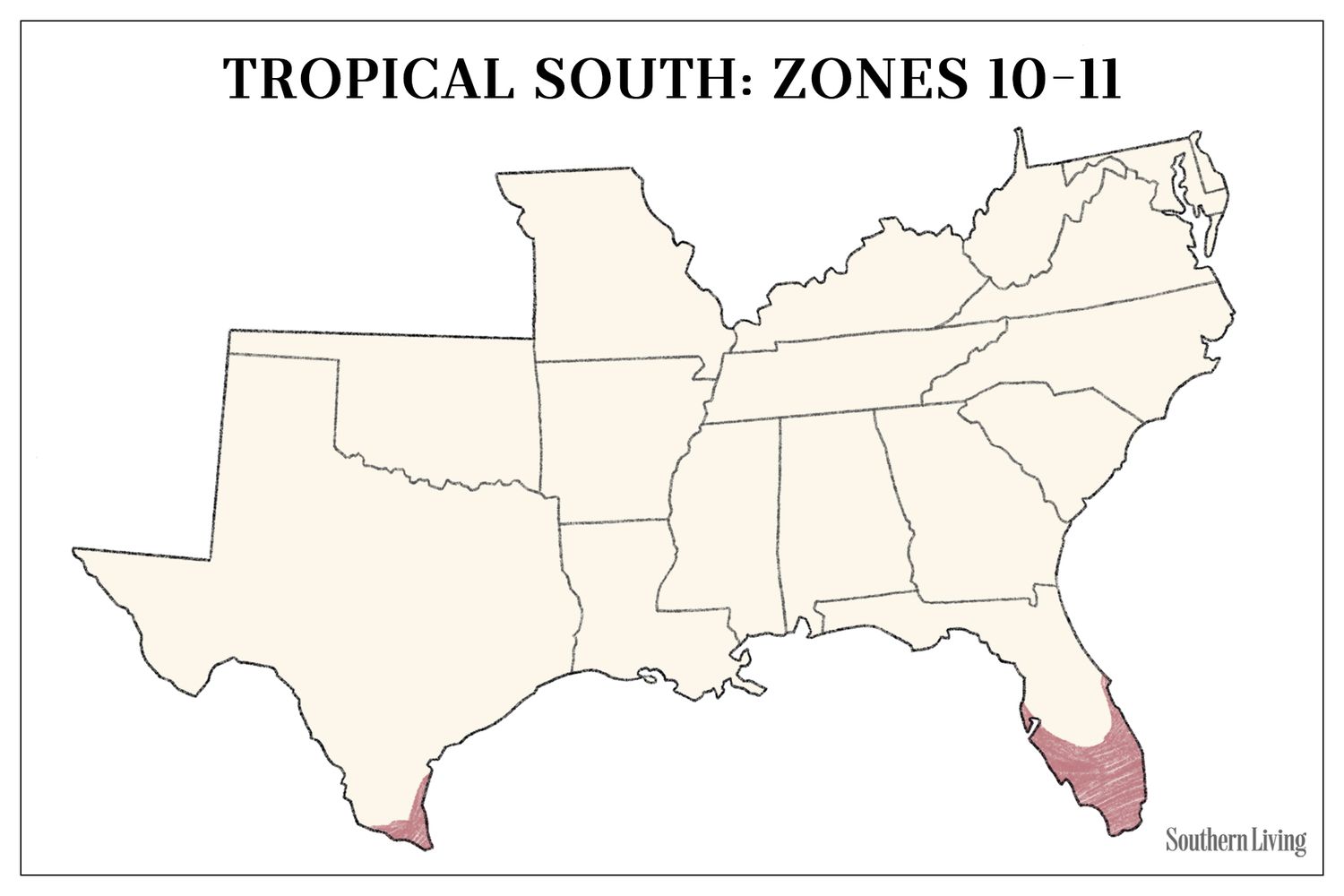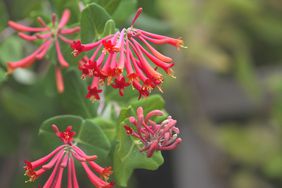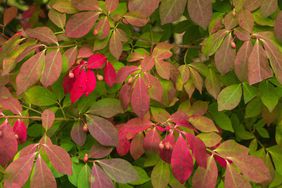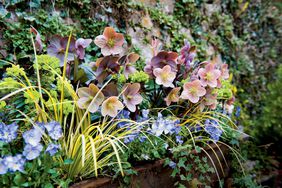Chances are, if you have any experience with planting anything, you’ve heard of planting zones. The USDA hardiness zone map indicating the areas in which a plant will thrive has become a go-to guide for gardeners and you can find zone info on just about every plant nursery tag. The latest version of the map—released in 2012—is based on 30 years of data gathered from weather stations across North America. It divides the United States into planting zones using the numbers 0 through 13 where each one is 10°F warmer (or colder) in an average winter than the adjacent zone, as well as increments of 5°F using «a» or «b».
However, for Southern gardeners, it’s important to note that because the USDA map reflects minimum yearly temperatures, it functions solely as a cold-hardiness map. In the South, heat is as much a limiting factor as cold. Therefore, when we give a plant a climate zone rating in the Southern Living Plant Guide, we take into account both summer heat and winter cold.
Southern Living divides the South into five broad climate zones:
- Upper South (US)
- Middle South (MS)
- Lower South (LS)
- Coastal South (CS)
- Tropical South (TS)
The boundaries of these zones correspond to those of the current United States Department of Agriculture (USDA) Plant Hardiness Zone Map. The Upper South is in USDA Zone 6, the Middle South in Zone 7, the Lower South in Zone 8, the Coastal South in Zone 9, and the Tropical South in Zones 10 and 11.
So, if we recommend astilbe as a permanent plant for your area, we mean that it will not only survive your winters but also endure your summers, and that it will perform satisfactorily for you. We won’t recommend astilbe for the Coastal or Tropical South, because although it can handle the winters there, in summer it melts faster than ice sculptures on a cruise ship.
Understanding Southern Climate Zones Better
Now that we’ve teed up the concept of consulting the Southern Living climate zones when picking plants, let’s tell you a bit more about the characteristics of each.
UPPER SOUTH (US): This region experiences the longest winters and shortest summers in the South, but summers are still hot and sticky. Fortunately, sizzling Southern temperatures rarely last long. Plants that need cool nights and long periods of winter chill do well here. Cold winters bring constraints, however. Frozen soil means that dahlias, cannas, glads, and other summer-flowering bulbs must be dug up in fall and stored over winter. Crepe myrtle, camellias, and figs may not be cold-hardy in all areas. The last frost occurs anywhere from mid-April to the first 10 days of May.

MIDDLE SOUTH (MS): This region forms a transition zone between warm-weather and cool-weather growing zones. Here you often encounter plants from the Northeast, the Midwest, and the Northwest growing along-side Southern natives. Summers are hot and, in most places, humid. The last spring frost generally occurs in the last two weeks of April.

LOWER SOUTH (LS): Spring comes early to the Lower South. Daffodils, flowering quince, and winter daphne open their buds in February. Though summer droughts are common, torrential downpours more than make up the difference. Snow is rare, but ice storms are not. The last frost generally occurs in the last week of March through the first two weeks of April.

COASTAL SOUTH (CS): Two large bodies of water—the Atlantic Ocean and the Gulf of Mexico—rule the Coastal South. Their close proximity ensures that winters are mild and brief but summers are long and humid. The last spring frost usually comes in the last three weeks in February. Spring commences in January, when the Japanese magnolias and common camellias bloom.

TROPICAL SOUTH (TS): Truly its own gardening world, the Tropical South rarely feels frost. In fact, the lowest temperature on record for Miami is 30 degrees. Whereas most of the South deals with dry summers and wet winters, a large portion of the Tropical South reverses that pattern. All sorts of lush, exotic plants with strikingly colorful blooms and foliage flourish. This region can seem like a paradise. But the lack of winter chill comes at a price. Azaleas, forsythia, hosta, hydrangea, and many other temperate plants fail here.
Popular Plants to Grow in Your Hardiness and Climate Zone
Plenty of plants can survive in a range of conditions, but if you want to fill your garden with plants that will really thrive in their forever home, it’s best to carefully match plant picks to the space in which they’ll live. That may mean letting go of a few of your favorites that just aren’t meant to be planted where you live. But with hundreds of perennials, shrubs and trees to choose from, there are gorgeous plants that will make any garden look great—no matter what zone you’re in!
Upper South (USDA Zone 6)
Best Time to Plant: The best time to plant is after danger of frost has past, usually May.
| Top Plants for Upper South | |
|---|---|
| Groundcovers | bugleweed (Ajuga), lily turf (Liriope), juniper (Juniperus), spurge (Pachysandra), sedge (Carex), thyme (Thymus) |
| Vines | five leaf vine (Akebia), trumpet vine (Campsis), honeysuckle (Lonicera), Clematis, Wisteria, Virginia creeper (Parthenocissus) |
| Perennials | aster (Aster), daylily (Hemerocallis), peony (Paeonia), black-eyed Susan (Rudbeckia), coneflower (Echinacea), speedwell (Veronica) |
| Shrubs | beautyberry (Callicarpa), Hydrangea, Forsythia, holly (Ilex), Rhododendron, Viburnum |
| Trees | maple (Acer), buckeye (Aesculus), shadblow (Amelanchier), redbud (Cercis), fringe tree (Chionanthus), dogwood (Cornus) |
Middle South (USDA Zone 7)
Best Time to Plant: The best time to plant is after danger of frost has past, usually April to May.
| Top Plants for Middle South | |
|---|---|
| Groundcovers | green and gold (Chrysogonum), spurge (Pachysandra), may apple (Podophyllum), Jacob’s ladder (Polemonium), foam flower (Tiarella), Sedum |
| Vines | Clematis, cross vine (Bignonia), Virginia creeper (Parthenocissus), Wisteria, passion flower (Passiflora), honeysuckle (Lonicera) |
| Perennials | Eastern blue star (Amsonia), Joe-pye weed (Eutrochium), false indigo (Baptisia), Coreopsis, black-eyed Susan (Rudbeckia), coneflower (Echinacea) |
| Shrubs | beautyberry (Callicarpa), sweet shrub (Calycanthus), witch hazel (Hamamelis), Viburnum, Fothergilla, holly (Ilex) |
| Trees | dogwood (Cornus), crabapple (Malus), redbud (Cercis), maple (Acer), Magnolia, sourwood (Oxydendrum) |
Lower South (USDA Zone 8)
Best Time to Plant: The best time to plant is after danger of frost has past, usually April.
| Top Plants for Lower South | |
|---|---|
| Groundcovers | beach wormwood (Artemisia), plumbago (Ceratostigma), Phlox, wild ginger (Asarum), bugleweed (Ajuga), creeping juniper (Juniperus) |
| Vines | trumpet vine (Campsis), cross vine (Bignonia), greenbrier (Smilax), passion flower (Passiflora), Carolina jessamine (Gelsemium), climbing jasmine (Trachelospermum) |
| Perennials | Crinum, lily-of-the-Nile (Agapanthus), Canna, Dahlia, Hosta, Iris |
| Shrubs | rose (Rosa), Rhododendron (Azalea), Camellia, sweet box (Sarcococca), winter daphne (Daphne), Chinese fringe tree (Loropetalum) |
| Trees | crepe myrtle (Lagerstroemia), fringe tree (Chionanthus), silverbell (Halesia), oak (Quercus), Magnolia, palmetto (Sabal) |
Coastal South (USDA Zone 9)
Best Time to Plant: The best time to plant is after danger of frost has past, usually March but this may vary by area.
| Top Plants for Coastal South | |
|---|---|
| Groundcovers | bugleweed (Ajuga), perennial peanut (Arachnis), spurge (Pachysandra), railroad vine (Ipomoea), lily turf (Liriope), mondo grass (Ophiopogon) |
| Vines | Carolina jessamine (Gelsemium), creeping fig (Ficus), Clematis, Bougainvillea, honeysuckle (Lonicera), climbing jasmine (Trachelospermum) |
| Perennials | lily-of-the-Nile (Agapanthus), Pentas, Cannas, Crinum, crown-of-thorns (Euphorbia), hurricane lily (Lycoris) |
| Shrubs | flame-of-the-woods (Ixora), Chinese fringe tree (Loropetalum), star anise (Illicium), banana shrub (Michelia), Camellia, Rhododendron (Azalea) |
| Trees | sweet acacia (Vachellia), Jacaranda, royal ponciana (Delonix), golden trumpet tree (Tabebuia), bottlebrush (Callistemon), oak (Quercus) |
Tropical South (USDA Zones 10 and 11)
Best Time to Plant: The best time to plant is from fall, when the temperatures cool down, to spring, before the summer’s heat comes back.
| Top Plants for Tropical South | |
|---|---|
| Groundcovers | Bromeliads, perennial peanut (Arachnis), creeping juniper (Juniperus), mondo grass (Ophiopogon), beach sunflower (Helianthus), pinks (Dianthus) |
| Vines | Bougainvillea, Mandevilla, climbing jasmine (Trachelospermum), ornamental sweet potato vine (Ipomoea), cross vine (Bignonia), Rangoon creeper (Quisqualis) |
| Perennials | ornamental ginger (Hedychium or Alpinia), Plumbago, spider lily (Hymenocallis), lobster claw (Heliconia), Pentas, bird of paradise (Strelitzia) |
| Shrubs | frangipani (Plumeria), oleander (Nerium), Jatropha, crepe jasmine (Tabernaemontana), cocoplum (Chrysobalanus), coral bean (Erythrina) |
| Trees | royal ponciana (Delonix), sweet acacia (Vachellia), oak (Quercus), sea grape (Coccoloba), golden trumpet tree (Handroanthus), buttonwood (Conocarpus) |
Considering the hardiness and climate zones in which you live is an important part of the equation, but it’s not the only factor. Sun quantity and quality, soil conditions and your own care practices like watering and fertilizing make a huge difference in how well your greenery will grow. But you can change or fix all those things; you can’t change the weather! So save yourself some trouble and make sure you’re paying attention to zone info the next time you’re picking plants.
Was this page helpful?
Thanks for your feedback!
Tell us why!
Related Articles

Texas USDA Planting Zones Explained

Expert Tips For Successful Gardening In Florida’s USDA Planting Zones

Zone 7 Plant Ideas For The Mid-South

The Best Plants For USDA Zone 9

The Best Plants For USDA Zone 6

15 Zone 8 Plant Ideas For The Lower South

5 Gardening Mistakes To Avoid This Fall

10 Plants for Cold-Weather Containers

These Invasive Plants Put on a Show During the Fall, But—Don’t Be Fooled—They’re Bad News

How To Incorporate Native Plants In Your Southern Garden

Winterberry Is Our Favorite Winter Plant for Southern Gardens

How to Plant and Care for a Winter Window Box

Asters Are the Fall Flower That Will Replace Your Mum Habit

30 Christmas Plants And Flowers To Decorate Your Winter Season

What Mum Growers Don’t Want You to Know

30 Shade-Loving Container Garden Ideas For Covered Porches
Newsletter Sign Up
Newsletter Sign Up
We Care About Your Privacy
We and our 1609 partners store and/or access information on a device, such as unique IDs in cookies to process personal data. You may accept or manage your choices by clicking below, including your right to object where legitimate interest is used, or at any time in the privacy policy page. These choices will be signaled to our partners and will not affect browsing data.
We and our partners process data to provide:
Store and/or access information on a device. Use limited data to select advertising. Create profiles for personalised advertising. Use profiles to select personalised advertising. Create profiles to personalise content. Use profiles to select personalised content. Measure advertising performance. Measure content performance. Understand audiences through statistics or combinations of data from different sources. Develop and improve services. Use limited data to select content.